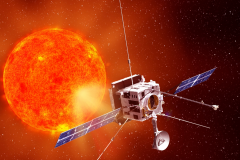The Sun and its extended atmosphere, the heliosphere, is a very complex system. The inner planets of the Solar System, including the Earth, lie within the heliosphere and its influence can sometimes be clearly detected by researchers and scientists during phases of high solar activity.
The Solar Orbiter mission, part of the European Space Agency’s Cosmic Vision program, has officially started on Monday 10 February (at 05,03 CET - European time) aimed at exploring the Sun and its heliosphere to improve our understanding of Space weather and its effects on Earth. It will observe the Sun and collect measures in an orbit ranging from 0.28 (closer than Mercury) to 1.4 AU (the Earth is at 1 AU). In addition, this mission will provide with a natural laboratory to study processes in fundamental physics, astrophysics and plasma physics that cannot be studied elsewhere in such detail.
The scientific payload of Solar Orbiter is composed of ten experiments. Among the instruments, the Solar Wind Plasma Analyser suite (SWA) will provide comprehensive in-situ measurements with very high temporal resolution of solar wind’s particles composition (ions, protons and electrons) and velocity distributions. The final goal is to establish the fundamental physical links between the highly dynamic magnetised atmosphere of the Sun and the solar wind in all its quiet and disturbed states.
The SWA instrument is composed of four sensors devoted to the analysis of particles at different energy levels. Two of the instruments measure electrons (Electron Analyser Sensor, or EAS), one measures protons and alpha particles (Proton Analyser Sensor, or PAS) and one measures heavy ions which are a minor constituent of the solar wind (Heavy Ion Sensor, or HIS). The instruments will independently measure 3D velocity distribution functions, evaluate density, speed, temperature and thermal flux of the plasma composing solar wind.
Italy cooperate at the SWA experiment providing the Data Processing Unit (DPU) through a project having Roberto Bruno of Institute for Space Astrophysics and Planetology (IAPS) as the scientific responsible and SWA principal co-investigator.
The SWA-DPU project provided the control unit dedicated to the data production and processing of the four sensors and will manage also the single interfaces of the spacecraft for telemetry, tele-commands and power management.
The role of Planetek Italia
Planetek Italia was invited to attend the launch day in Florida, as part of the SWA DPU team who worked on the DPU of the Solar Wind Plasma Analyser (SWA).
Watch the photos and interviews at SWA DPU team leaders.
The project is in charge of a group of companies composed by TSD, Planetek Italia, Sitael and Leonardo. Planetek Italia activities focus on the on-board software for scientific data processing, on the ground segment software for the data processing and communication pakages management.
SWA sensors collect the particles composing the wind; one of the main task in the on-board data handling is the evaluation of “moments” in phase space, i.e. mathematical expressions able to characterise wind considered as a plasma flux. However, as evidenced by the scientific team, such a calculation needs of a significant percentage of total computational resources, so we are developing optimal implementation custimised to the specific data involved. The same approch has been adopted in order to define which is the compression techniques best fitting to data. The development of an optimal solution specifically designed on the SWA data flow was obtained with an optimized software architecture and a close collaboration with the IAPS scientific team.
The same approach was adopted to define the compression technique which better suited to data. For the purpose, Planetek has evolved software modules already developed using the experience gained in the previous SpacePDP project.
In phases C and D Planetek also developed the software system in the Electrical Ground Support Equipment (EGSE) for the integration and testing of the suite.
More info:
- Read and download the article from the GeoXperience Magazine (PDF)
- Everything about the Solar Orbiter mission on the official ESA Website
- Download the Solar Orbiter ESA interactive media kit to know more and watch videos and images.






